
(Images via Streetmix.net – mix your own)
Anyone who’s ever been close to the Burnside Bridge’s eastbound lanes out of downtown has heard it: the roar of car engines as people see three mostly empty lanes of roadway ahead of them and hit the gas.
Thirty seconds later, of course, they’ll likely as not be sitting at the stoplight on the east landing of the bridge, along with everyone who didn’t jam the gas pedal.
Why does the Burnside Bridge need three lanes of eastbound auto traffic when it has only two lanes westbound?
Which raises the question: Why does the Burnside Bridge need three lanes of eastbound auto traffic when it has only two lanes westbound?
We don’t yet know much about the split seconds that killed Ben Carlson and wounded Bridget Larrabee Sunday, though according to KGW the man who hit them with his car, Douglas Walker, had “choked on a soft drink, passed out and lost control” before careening onto the sidewalk. But at 2 p.m. on a weekend afternoon, we know the situation on Burnside’s eastbound roadway at the time: almost certainly vast and empty.
The Burnside was built so wide because, before 1950, each direction had two lanes of auto traffic and one lane for streetcars. If we returned to that pattern by removing one of the two eastbound passing lanes, would it change the freeway feel of the street as it rises out of downtown?
If the lanes were changed, could the road space be used in other useful ways? What if better traffic barriers were part of that?
I’ve spent much of today talking with traffic experts and officials and looking at what could be done to make Burnside less of a highway and more of a street.
Buses carry 14 percent of eastbound traffic across the Burnside but get 0% of the lane width
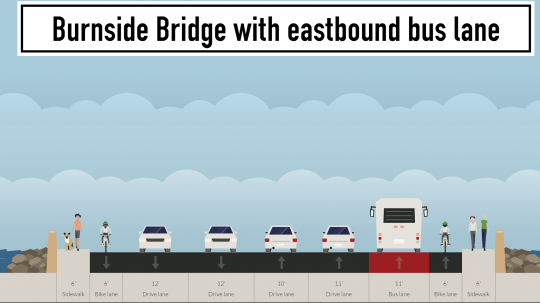
Three TriMet lines run on the Burnside: the frequent-service 12 and the almost-frequent 20 and 19. (TriMet has said the 20 is a candidate for upgrading to frequent service.) During rush hour, every person driving or biking already knows that anyone in the right eastbound lane of Burnside downtown is likely to get stuck behind a loading or unloading bus, so many people try to merge left and then merge right in front of buses on the uphill.
And here’s the thing: TriMet estimates that the buses carry about 3,780 eastbound passengers a day. Assuming that the average car or truck has 1.2 passengers, that’s already 14 percent of all eastbound vehicle traffic across the bridge. (Cars carry about 82 percent, bikes 5 percent.)
What if the rightmost lane of the Burnside were dedicated to buses? This would maximize space efficiency on the bridge by letting the most space-efficient passengers (bus riders) jump the rush-hour traffic queue just as bike users are currently able to.
This would mean one fewer through lane of auto traffic could fit through the eastbound signal at MLK, so during two hours each weekday, some people driving would probably have to sit through an additional 60-second signal cycle. But because they’d be doing it in the middle of a half-mile-long bridge, this wouldn’t lead to any trouble elsewhere in the system.
The Burnside Bridge area is growing like crazy and bike traffic keeps rising

As we’ve reported, some of the city’s bike-friendliest new apartment buildings are about to go up in the Burnside Bridgehead area near the bridge’s east landing. But what good are on-site facilities if it’s not comfortable or attractive for someone to walk or ride a bike across the Burnside itself?
Bike traffic across the Burnside Bridge keeps rising steadily, the latest city counts show. Working with developers, the county and city could turn the Burnside Bridge into a hey-look-at-this green carpet into downtown.
Because the Burnside Bridge raises 45 degrees into the air during its lifts, planters, jersey barriers and maybe even grassy strips wouldn’t be possible across the span. But those elements, especially a little greenery, could add a lot just to the other parts of the bridge, and make the whole area the sort of place people naturally slow down and appreciate rather than zooming through as fast as possible — even when they’re behind a wheel.
There’s even enough room to do both
Here’s something else: given the fact that 12-foot-wide traffic lanes like the westbound ones on the Burnside are known to be unsafe, why not narrow them a little and make room for high-quality facilities for both bike and bus?
Would an extra curb built into the roadway beside the bike lane have saved a life yesterday? It’s hard to say. Certainly curbs have the effect of narrowing the roadway and leading people to drive more carefully. In any case, there’s no question that people strongly prefer to bike in curb-protected lanes, not just because they feel safer but because they feel more comfortable.
If we did this on the Burnside, people would get 15 percent of the eastbound space of the road bed if they travel by bike; 28 percent if they travel by bus; and 56 percent if they travel by car.
That gives more space per person to people biking and busing than people driving. But it’d almost certainly make more people choose bikes and buses. And in a city aiming to get 25 percent of trips on transit and 25 percent on bike, it seems only appropriate. How else is this change going to happen?
Advertisement
One fewer eastbound lane wouldn’t worsen gridlock, experts say
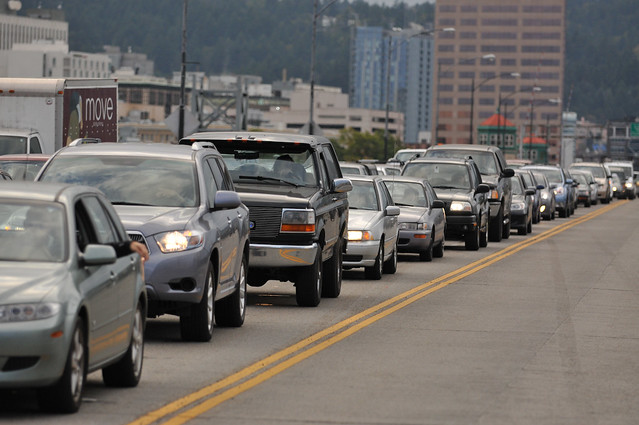
I asked some transportation pros what they thought about the concept of removing an eastbound lane from cars. Would it cripple auto traffic across the bridge, which is already crowded during rush hour?
It wouldn’t. At worst, people choosing to drive over the bridge during rush hour would have to wait through an extra traffic signal cycle or two, and because the bridge is so long, it wouldn’t lead to spillover effects elsewhere.
Here’s Ray Delahanty, a transportation planner for DKS Associates:
The eastbound throughput is limited by that signal at Burnside/MLK. If you were going to design that eastbound approach to the signal in a completely motor vehicle-centric way, maximizing throughput at the signal, you’d want to make sure you had three eastbound through lanes and a right turn lane extending far enough back to store all the vehicles that need to get through during the light’s green phase. That’s pretty close to what they have now.
So, back of the envelope, assuming 60 seconds of green time each cycle and a gap of two seconds between each car, you’d need queue storage for 30 cars per lane (less for the right-turn lane, since they will flow more slowly due to turning and, presumably, yielding to pedestrians). Assuming 25′ per car, that’s 750′. Anything beyond 750′ is excess queue storage for vehicles that were not able to get through the signal on the first try. And if it’s excess queue storage for vehicles that aren’t going to be able to make it through the signal, you don’t need three lanes — two will do fine. The bridge is 2600 feet or so, so there’s definitely room to do SOMETHING. And remember, this is thinking of the design purely from a motor vehicle throughput perspective.
Another consideration — you would have to merge from 3 lanes to 2 lanes at some point, since West Burnside is 3 lanes approaching the bridge eastbound from downtown. It would be tough to rightsize this section, since it does get really congested — a lot of times when I take the 12 in the evening, you get stuck for several signal cycles in between SW Broadway and SW 2nd. However, if you could make the right lane bus-only, that would solve the problem somewhat. Anyway, traffic engineers hate lane drops/merges, so that’s a tough sell if you’re thinking about having two lanes merge together eastbound once you get through the signal at SW 2nd. Although the “safety” issue here would probably mostly be vehicle/vehicle sideswipes, which aren’t anything remotely close to what we saw on the bridge this week in terms of severity.
One last thing — my experience is that Multnomah County doesn’t have any policy issue with doing restripes or other cross-section changes on bridges as long as the changes aren’t a liability. They defer to PBOT on the traffic considerations, as they did at the east end of the Hawthorne when the buffered lane and sidewalk were added eastbound at Grand. I don’t think ODOT has an interest in the Burnside either, so it’s really a question for PBOT traffic. … I’d be surprised if they wouldn’t seriously consider major cross-section changes on the Burnside.
Here’s Todd Mobley, a traffic engineer and principal at Lancaster Engineering, on the possibility of mitigating any such delays:
The bridge itself could afford some protected facilities to avoid crashes like we just saw. The intersections (particularly the first one) on the east end could have a different type of treatment for people on bikes or other vulnerable users. It is still really wide at the intersection, so depending on what the protected treatment would be coming across the bridge, it could transition into something different at the intersection that may have different capacity/delay impacts.
County and city: We’ll be discussing possible changes
As with most of Portland’s Willamette River bridges, Multnomah County controls the Burnside Bridge. I asked county spokesman Mike Pullen if he had any comments on possible lane reallocations.
Here’s what he said:
The city is the road authority for the sections of city roads that cross the county bridges. For example, the city can ask the state to change the speed limit on the bridge. In 1995 for example the city decided that the volume of bike traffic on the Burnside Bridge sidewalks had increased to the point where it made sense to eliminate a traffic lane to create two bike lanes and move bikes off the sidewalks.
The city and county work together on these projects, but we play different roles. On the Morrison Bridge there was a history of crashes from motor vehicles spinning out on the old open steel grating deck on the lift span (since replaced). A crash there led to a pedestrian fatality on the sidewalk. The city and county engineers agreed that a crash barrier was a sensible improvement on the Morrison Bridge due to conditions and the crash history there.
The Burnside Bridge hasn’t had a similar crash history. Yesterday’s tragedy will need to be looked at to determine if patterns are changing or if this was a freak accident.
And here’s city spokeswoman Diane Dulken:
The police are still investigating, and we look at all incidents and the circumstances behind them and then look at what safety improvements may be warranted and may be possible. … I cannot say what we will be doing but we will be having a conversation. … It’s too early for us to comment on any specific proposal. there are other options, but right now this is the early stage.
According the city’s Vision Zero safety map, the Burnside Bridge (including the intersections immediately east and west, which are recorded as the site of collisions on the bridge itself) saw 126 reported traffic injuries from 2004 to 2013. Eight of those people were biking, 14 of them were walking and 104 were driving.
Update 6/16: The sidewalk widths here were estimated using Google Earth because the city and county don’t have exact figures. On the bridge span, the sidewalk and rail area is nine feet wide total.



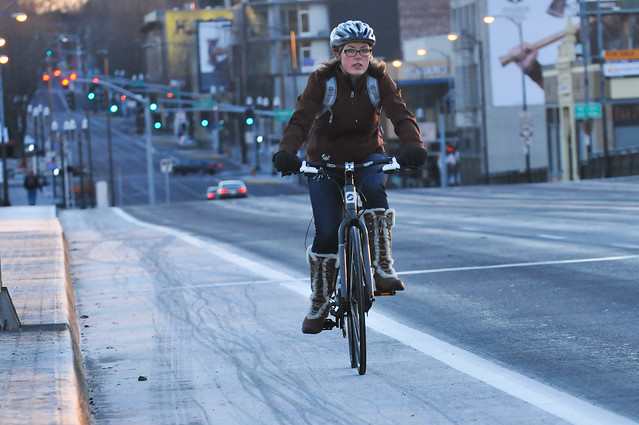
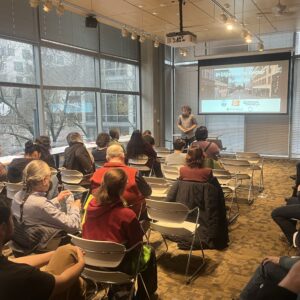
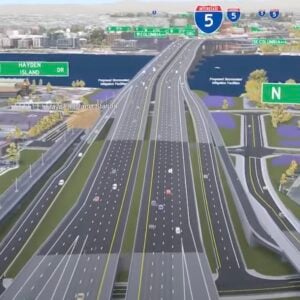

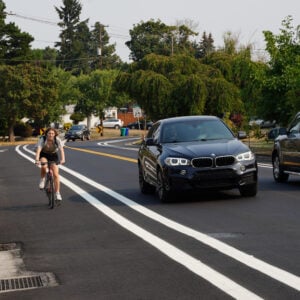
Thanks for reading.
BikePortland has served this community with independent community journalism since 2005. We rely on subscriptions from readers like you to survive. Your financial support is vital in keeping this valuable resource alive and well.
Please subscribe today to strengthen and expand our work.
The 3rd option is the only one that makes sense.
Now make those bike lanes 8ft wide (plus the 2ft jersey barrier) and 9ft for the vehicle lanes with 1ft in the middle.
We could even do movable bollards and switch lane directions at rush hour (not that traffic would need this.)
M,
did you mix up directions in that third paragraph?
I did. Fixed now, I think.
Evening buses get so choked in traffic that I refuse to ride them after about 3pm heading to the east side. I’ve been wondering for years why those three bus lines can’t have dedicated space in the eastbound direction. It’s not needed for cars and it IS needed for buses.
I’m also starting to feel more and more vulnerable on my bike as I continue to see these unnecessary collisions become commonplace. We should be attempting to not just make biking safe, but also more comfortable for all ages, so I would narrow the lanes and buffer the eastbound bike lane with a bus lane that begins as far back as SW Broadway.
What’s stopping us from having a better city??
Politicians are scared if they do anything nice that they’ll suffer at the hands of folks who have other issues they would like to see funded first. What fails in that conversation is that for certain things (like human-centric transportation infrastructure) return on investment is so good that it can help pay for other causes.
Eg sidewalks are seen as competing in the same funding conversation as parks, police, and schools. What goes unsaid is that pedestrian first thinking would allow us to establish a baseline which *almost none of our city meets* but by agreeing on that baseline we can move forward by applying it first in the neighborhoods without sidewalks. And the result would be an economic boom that includes everyone.
We need to move beyond the project-by-project “how human friendly will this be?” mindset to a mindset that assumes a baseline answer of “as human friendly as possible” so we can stop focusing on secondary concerns like how many cars fit through a Burnside light cycle. If we are going to design for throughput instead of comfort and delight, let’s remember that pedestrians are traffic too.
Once we stop fighting about how what a safe street looks like, rolling out the infrastructure can be done equitably, starting from the outside and working our way in. This should be our focus, so let’s not just repave 122nd, let’s do it in a people-first way, and invest in walkability throughout the adjacent neighborhoods.
The opportunity cost of not doing this is staggering. The risk is that our current city leadership can’t tell the difference between a people-first redesign program, and doubling down on the status quo.
It probably could never work with bus stops, but a center, transit-only pro-time lane would allow w’bound busses in the morning and e’bound in the afternoon/evening. that said, I am a fan of option 3 with bus and bike, and I echo Jayson’s comment that the bus-only lane should stretch from Broadway on the west side and I would add that it should extend to Grand (or 12th as a pro-time, 3-7pm bus-only lane) on the east side.
Another thing to think about if we want to re-imagine our bridges at a human scale – they no longer must be something that connects destinations, they can also BE destinations. When I was in Copenhagen, I couldn’t help but imagine if the Burnside bridge were like the Dronning Louise’s bridge. We’ve got plenty of room to make this thing human friendly and if there were political will, the money would be found.
There is no way a restripe/road diet of Burnside Bridge makes sense without at least including a pro-time eastbound bus only lane. Those are 3 highly-used lines that would be consigned to major delays and worsening reliability if the only thing done is reducing eastbound travel lanes from 3 to 2.
I agree with the suggestion of making the right-hand lane bus only between Broadway and 12th. If anything, the city and TriMet should experiment with floating bus islands on the eastbound Burnside stops between MLK and 12th. Too many conflicts between stopped buses and bicycles in the painted lane.
Floating bus stop idea seconded. I ride Burnside eastbound on my return commute in the afternoon and dodging the bus at stops from SW 4th through to NE 12th is a big part of the stress.
Pro-time doesn’t really make sense, because in the off-peak the cars don’t need the third lane anyway. Far easier to just make it bus-only the entire time.
As far as putting in a bus-only lane west of the bridge, it would make sense to start it at Park Ave rather than 12th, since Park is where Burnside widens out.
Whoops, I thought you were talking about W Burnside! I suppose the bus lane could continue on E Burnside to 12th, but it’s less necessary. The worst delay is at MLK/Grand–it’s not too bad east of there.
Thank you for introducing me to Streetmix. Here’s my mix of the Burnside Bridge:
http://streetmix.net/-/247218
Plenty of room for everybody. Also, there ought to be a way to use a single bus lane for two-way traffic with timing or signals.
The problem I see with the right side bus lane is that motorists turning right on MLK would need to cross two through traffic lanes (bus, bike) before they could get to the right turn lane. I don’t trust the competence of the average driver to successfully complete this maneuver on a regular basis.
That would be a design challenge, sure, but not insurmountable.
Perhaps that right turn should be blocked. If motorists need to be on Grand, they can take one of the other bridges. Problem solved.
Not a bad idea, given that the Hawthorne and Morrison both offer flyover ramps that making getting to MLK southbound very easy. Eliminating the right-turning traffic from Burnside eastbound would reduce traffic on the bridge, which would further support the reduction of one eastbound lane. Motorists would always have the option of taking three lefts (Grand, Couch, MLK) to go south, if needed.
The Ross Island bridge, Steel and Broadway also have decent access to Southbound 99E. This simple change would speed up general traffic and make the bus / bike routing much more simple.
or do the turn left to go right thing. North on MLK, left on Couch, south on Grand.
The right turn merge could happen in advance of the right turn lane, so that people driving could see any conflict with people biking. – a 2 stage merge.
This is confusing…I think you have MLK and Grand mixed up. And what’s the 2-stage merge?
option 3 is brilliant
encouraging people to walk, bus, and cycle is the Portland thing to do.
The bus only lane would work, but the bus only part would end in the middle of the bridge. This would allow the motorists to merge and move by the time they reach the right turn signal.
Next! instead of a minicurb use the cable barrier similar to the one our councilwoman got installed on I-5. But steel posts with 3 cables. The posts 10 foot apart. Not too heavy for the bridge structure. Guaranteed to shred a car or SUV instead of taking out peds or cyclists.
Arent those cables designed to flex out up to ten feet when hit by a motor vehicle?
I’d like some drought-tolerant “street” trees.
This is a BRIDGE. No soil for trees. And the center of the bridge tilts up.
If high-rise apartment rooftops can have trees, then bridges can bloody well have trees as well. They are grown in things called “planters.”
When I grow up, I want to be a traffic engineer.When I grow up, I want to be a traffic engineer
High rise apartment rooftops have little sapling trees that are just ornamental. A street tree needs to be big enough to provide useful shade, which means larger trees, which don’t grow in planters. And check out the size of the planters used for even little ornamental trees. How much roadway width do you want to take up with planters, how much narrower would you like the bike path to be, just to have a line of small ornamental saplings?
Eucalyptus trees: they grow anywhere. They don’t care.
“How much roadway width do you want to take up with planters, how much narrower would you like the bike path to be, just to have a line of small ornamental saplings?”
I’d like about 4′ on each side.
Ted Buehler
Michael, The official Burnside Bridge width is actually 86′ I did some changes using the new measurements and came up with this http://streetmix.net/-/247305
That’s true, Scott, but I think it includes some additional width outside the sidewalk? The lane widths here are a precise reflection of what’s between the current curbs; got my info from the city. The sidewalk might be a little more than 6 feet but based on my Google Earth measurements, I don’t think it’s much.
I would agree, but only 2′-3′ which still gives it a width of 83′-84′ which means a couple feet on the north sidewalk, my thinking with the sidewalk was that the North Sidewalk has far more walking volume so adding a larger surface there makes sense.
Thanks for a great article.
This is a perfect example of what Vision Zero is all about. Here we have a crash that really was an “accident” from the point of view of the driver, and yet it was completely preventable. The street could be designed to slow cars down, rather than encouraging them to speed up after crawling along W Burnside. It could have more physical protection (curbs or cable barrier), or even just visual protection (like bollards) that would act as traffic calming by narrowing the sea of concrete. A red-painted bus lane and green-painted bike lanes would also help create more visual cues to slow down and be careful. While it may seem like a freak occurrence, we can’t just throw up our hands and give up. Vision Zero treats every death as preventable, and we need to focus on solutions.
When I drive or bike E/B on the Burnside Bridge during afternoon rush hour, I observe:
– The right most lane of Burnside approaching the bridge is effectively only used by buses, cars turning right, and me (cyclist). Drivers know that lane is clogged by buses so they avoid it.
– The traffic jam on the bridge E/B and on East Burnside E/B is partly caused by signal timing. The signals going E/B are timed, but not that well, so when you get the green light at the east end of the bridge, you usually make only one more green light then get stopped at one or more signals before Sandy. The signal timing should be improved so that traffic can flow slowly (10-12 mph) but steadily all the way past Sandy.
Option #3 looks nice, and I’d add bollard or curbs to the bike lane buffers. I’d also add bollards on the centerline.
Do the last option, but with Jersey barriers on the parts of the bridge that don’t move during a lift. If you can’t put a divider on the lift span itself then you might need posts where the barriers resume after the lift span on both sides so some idiot doesn’t try to change lanes & drive his car down the bike lane. I’m willing to accept a slightly narrower bike lane to get the security of the barrier.
The east-bound bus lane is a good idea, too. It incentivizes getting people out of cars where possible.
This! I wish you’d been on the protest fb event page last night. I was badgered by a woman who just kept saying that we don’t know what happened and we shouldn’t demonize the man and drivers *need* to drink. But if we just shrug and let this go then this perfect storm of a moment is gone.
We need to start Vision Zero now, not after a committee studies the idea!
w/ trees
http://streetmix.net/-/247486
trees would obviously not ride the moving decks…those zones could be expanded bike or pedestrian areas or just a buffer line
How could trees even be installed on the non-moving part of the bridge?
if you want something substantial enough to be a shade tree, foliage tall enough to clear buses and trucks, then that is fairly big tree. With a sizeable root system. Which need to grow in soil, not in the concrete and steel supporting the bridge deck. Along with a watering system, access for maintenance, sweeping to remove slippery fallen leaves from the roadway and bike path . . .
Forget the trees already, it isn’t a viable idea.
“Thirty seconds later, of course, they’ll likely as not be sitting at the stoplight on the east landing of the bridge, along with everyone who didn’t jam the gas pedal.”
–Or, they just blow through the light. The street lamp at the NE corner of Burnside and MLK has been taken out twice in the last 6 months!
In the past, getting on the B-side bridge heading east, I have been guilty of applying the throttle heavily. Heading up on to the bridge with huge amount of open width in front of me was just too much of a temptation. Like a drag race up the hill. And I had a turbocharged car that sounded GREAT at WOT.
However, since I got a speeding ticket from a PPB photo van (this was probably 8 years ago), I dont drag race up that hill any longer…well that, and the fact that I no longer have that fun car….
As a bicyclist in the area, I find myself NEVER taking the B-side bridge. I don’t even consider it an option for me when I am on my bike. Why climb up that thing when I can easily skirt across the river on many other (better) bridges for bikes? I do regularly cross bridges, mostly Broadway and Hawthorne. The speed differential between bikes and cars in close proximity is just too large. Like riding on N. Greeley by the RR yard… No thank you.
“Why climb up that thing when I can easily skirt across the river on many other (better) bridges for bikes?”
Possibly because every WIllamette River bridge is a climb except for Hawthorne and the lower deck of the steel. 2 routes out of 8 (counting Ross Island, and who wants to bike THAT?) isn’t exactly “many”.
Honestly, the Burnside is the third best bridge for crossing after the Hawthorne and Steel – at present, anyway.
Easy: http://streetmix.net/-/247580
If high-rise apartment rooftops can have trees, then bridges can bloody well have trees as well. They are grown in things called “planters.”
When I grow up, I want to be a traffic engineer.When I grow up, I want to be a traffic engineer
It’s a drawbridge so weight is an issue.
High rise rooftop gardens have little ornamental trees, basically potted plants, that would be useless as a street tree. And even those little ornamental trees live in substantial planters that would take up a meaningful amount of roadway or bike lane. Do we want a narrower bike lane, fallen leaves, watering and maintenance expense, just to have a line of ornamental saplings on the bridge? For what? To be shaded by such a tree, you’d practically have to be sitting on the planter.
None of these options would of prevented the recent death. Jersey barriers would.
Doesn’t matter because cars can drive onto sidewalks anywhere anytime. It happened on NE 28th several years ago.